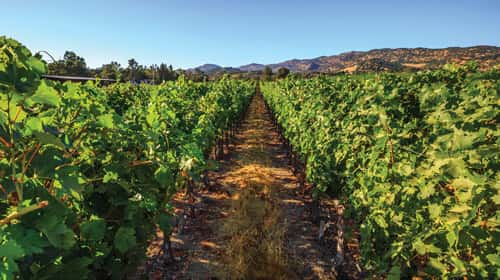Ask Napa County officials and community stakeholders what keeps them awake at night and they might cite the county’s lack of affordable housing, together with traffic congestion and desperately needed road repairs and upgrades. In October, out-of-control wildfires also added to their unease.
In the east half of the county, the Atlas fire burned approximately 51,600 acres and containment took more than three weeks. On the west side of the valley, the Partrick and Nuns fires threatened to do similar damage before being stopped. The death toll from the fires in Napa County stood at seven in early November.
November.
CAL FIRE estimates 705 homes were damaged in Napa County’s unincorporated areas, 87 percent of which were destroyed. According to David Morrison, the county’s director of planning, building and environmental services, the county lost 5 percent of its rural housing to the fires.
Like so many other areas of California, Napa County’s housing prices and traffic go hand in hand. Traffic is congested because the high price of housing forces many people who work in the county to live elsewhere and commute. Losing hundreds of homes to wildfires will only exacerbate this problem.
“The post-World War II model of spreading housing into the hinterlands is exhausted,” says Morrison. “But that doesn’t mean we stop development in Napa. It means we have to be more creative to find additional housing.”
The county’s Agriculture Preserve, enacted in 1968, established agriculture and open space as the best use for land in the unincorporated area of Napa County. This constrained the building of new housing to the incorporated cities, placing a unique pressure on the cities. “The Ag Preserve is a blessing and was very forward-thinking 50 years ago. It drew a line and showed where the urban growth could take place, and that’s why we are where we are today,” says Ryan Gregory, supervisor of Napa County’s second district. “But we are running out of land to use for development, and what’s left is getting more expensive. We also prefer not to widen our two-lane highways, so that we can keep the rural character.”
Belia Ramos, county supervisor for the 5th district, grew up in Napa Valley and now represents a population of approximately 27,000. She says many of the problems plaguing the county in 2017 are not new. “Some of the same challenges we face today go back decades. Even when I was a girl, there was traffic congestion in St. Helena on a Saturday, and it’s still congested today. The quantity of the traffic may be different, but it’s still there. Our roadways are our roadways.
“Part of the ‘problem’ is an acknowledgement of our success,” she adds. “We residents wake up every day and try to get to work. Visitors wake up and say, ‘We’re going to Napa Valley today.’ People dream of coming here, and we are the stewards for those visitors.”
More residents on the way
Housing and traffic issues aside, new residents will continue to settle in Napa County. The State Department of Finance projects that Napa County’s population will increase by 20,000 in the next 25 years, according to Morrison. “That’s what the state would like to see, and it’s up to the county to create opportunities for housing to happen. In Governor Jerry Brown’s administration, the state has been clear in emphasizing that no community can build a moat around itself and say it will stop growing.
“If there continue to be jobs available in Napa County and we need a workforce, we have to find ways to create housing for these many new residents. The state tells the counties to figure it out––to focus on what we can do, rather than what we can’t.”
what we can do, rather than what we can’t.”
“As we have housing supply constraints, we will be faced with employees commuting from farther distances,” says Ramos. “It may be through personal choice, so they can have more disposal income, or a lack of housing availability close to their work in their price range.”
Governor Brown recently signed a package of bills aimed at easing the affordable housing crisis in California. According to one state report, California must build 100,000 additional affordable housing units every year to stay up with the demand. A $4 billion housing bond, part of the legislation that received the governor’s signature, still needs voter approval in 2018.
In the interim, Morrison says Napa County has moved forward on approving accessory dwelling units (ADUs), while also making provisions to allow junior accessory dwelling units (JADUs). “We are putting more emphasis on working with the cities to find more housing, and we suspect there is a fair amount of existing housing suitable for these units.” Many homeowners, he says, have already contacted the county seeking more information about converting a garage or bedroom in their homes into a rental unit.
“The theme is how to develop more housing by making the most of what we already have,” he adds.
School enrollment impacts
Napa County has an aging population that exceeds the state average, according to Ramos. “There are far more people in their 50s, 60s and 70s who are aging in place. As a result, the turnover in houses we once saw, for new families to raise their children and start school, isn’t growing.”
Morrison says his own Napa neighborhood reflects that change. “There aren’t many young children around anymore. Anecdotally, I also hear that about other neighborhoods.”
It’s not his imagination. Student enrollment in the Napa Valley Unified School District, which encompasses American Canyon, the city of Napa and Yountville, has dropped significantly in recent years. “Our district was always growing mainly because of American Canyon’s growth,” explains Patrick Sweeney, Ed.D, superintendent of the district. “Our highest enrollment year was 2014-2015, with 18,237 students. Three years later, we are down 500 students, most from the elementary schools. Our district is funded by the number of students enrolled, so that’s a big hit to our budget.”
Sweeney blames the high cost of housing for the steep decline. “In 2011, the average home price in Napa and Yountville was $413,000. That year, 650 homes were sold that added 316 students to our district. This year the average home price is $632,000 and the number of units sold, also 650, brought us only 187 students.”
Some of the district’s teachers also cannot afford to live in Napa Valley, he says, and commute daily from such cities as Fairfield, Vacaville, Vallejo and Petaluma.
Last spring, the district offered early retirement incentives for teachers and other staff as a way to cut expenses. “We had very few layoffs because 56 teachers chose to retire,” says Sweeney. “We don’t anticipate having to close any schools, but in 2018 we will consolidate two small elementary schools into one and repurpose the other facility to accommodate a middle school that is currently sharing a campus.”
Housing location wish-list
“The Ag Preserve is what will ensure our agriculture legacy until the end of time, but it’s a constraint on what we can build,” says Ramos. “That requires us to work closely with our other jurisdictions to ensure we’re able to bring housing projects to the finish line.”
Ramos points to two projects in particular: a Burbank Housing development proposed on Redwood Road, and the efforts to close a funding gap in a senior and veterans housing community in American Canyon called Valley View Senior Homes.
“There’s also a unique opportunity to create more housing at the county’s Old Sonoma Road site of almost nine acres,” says Ramos. The site became available for redevelopment when the county Health and Human Services agency relocated. In October, discussions were still underway to determine a future use for the site.
To help with the effort to build affordable housing, the county collects fees from developers through a “housing impact fee” established in 1992, and invests those funds in specific projects. Approximately $2.8 million is currently available for this purpose.
Meanwhile, Napa Valley College is taking preliminary steps to build apartments on college property for student housing. The parcel of land being eyed for a village-like development is south of Imola Avenue near the college. An early plan for the site envisions a three-story complex with housing for more than 300 students and faculty, along with retail space. How to pay for the project, which could cost approximately $70 million, hasn’t been decided.
The long-awaited redevelopment of the old Napa Pipe site in southeast Napa is undergoing environmental work and soil remediation before new construction can begin. Plans still call for a Costco store and other retail on the property, closely followed by hundreds of housing units. But progress has been slow. “The developer is looking at making some changes to the project, rephasing it to be more suitable for their financing,” explains Ramos. “It’s fair to say that the housing part of this project is still a few years away.”
Road repairs
Alleviating traffic congestion, repairing roads and upgrading transit options are all on the wish lists of Napa County motorists, along with city and county officials. Fortunately, recently passed state legislation and the enactment of the county’s Measure T should bring relief as new projects get underway in 2018.
Gasoline tax increases that began in November will raise an estimated $5.4 billion annually for 10 years to pay for a huge infrastructure improvement plan throughout California. Senate Bill 1 was signed by Governor Brown in April and is the first gas tax increase in the state in more than 20 years. The California Road Repair and Accountability Act of 2017 will fix roads, freeways and bridges, while also funding transit and pedestrian and bicyclist safety projects.
SB-1 would initially bring approximately $5 million to Napa County for local streets and roads, according to Kate Miller, executive director of Napa Valley Transportation Authority. The No. 1 congestion headache in the county, she says, is the junction where highways 29, 12 and 121 (Soscol Avenue) intersect south of Napa.
More road repair funding for the county is on the way. Measure T, passed five years ago by voters to pay for road maintenance, becomes effective July 1, 2018, when the half-cent sales tax for flood control expires. At the time of the vote, Measure T was expected to raise $282 million over 25 years for fixing potholes, repaving roads and numerous other maintenance projects on streets throughout the county.
“We are now pulling together our plans and entering into funding agreements to oversee the NVTA board’s efforts on this program,” says Miller. “We will adopt our expenditure plan in the spring. When the money starts flowing it goes directly to the jurisdictions and the county, and NVTA will monitor and report on it.”
Measure T will bring an influx of new money for roads, according to Supervisor Gregory. “We’ll start to see street maintenance soon taking place all over Napa County at an unprecedented rate,” he adds. “We will begin with the worst roads and go from there.”
Roundabouts and repaving
Roundabouts, also called rotary traffic circles, promise to ease future congestion in Napa city. On the east side, the “five-way” intersection––where Silverado Trail, Third Street, East Avenue and Coombsville Road all converge––will be re-engineered into two roundabouts. The timeline for the project calls for construction to begin by mid-2022, with completion in 2024. The cost is estimated at more than $8 million.
“Thirteen configurations were considered for the 5-way intersection, and the city conducted several community meetings to discuss the pros and cons,” explains Eric Whan, deputy director of engineering for the City of Napa. “Roundabouts are common in Europe and in other parts of the United States, but California has been slow to come to the party. Even I was skeptical of roundabouts until one was built near where I currently live. At first I thought, no way will this work, but within a couple of weeks I wondered why we didn’t have more of these in California. They are so efficient and relatively simple to use.”
Another ambitious roundabout project is planned for the First Street exit at Highway 29, considered the gateway to downtown Napa. Three traffic circles will replace intersections linking California, First and Second streets together with the northbound exit ramp to First Street. Instead of heeding traffic signals and stop signs, drivers will keep moving steadily through the roundabouts to their destinations.
“Roundabouts can sometimes be more cost-effective to build than new signal-controlled intersections,” says Whan. “The First Street project will cost about $13 million, but redoing that entire interchange with a new structure, new lanes and new lights would cost between $40 and $60 million. There’s also much less maintenance with roundabouts.”
Safety is also an advantage, he says. “Roundabouts eliminate the possibility of dangerous T-bone’s or broadside accidents, which can happen with red light runners.”
The city of Napa is also continuing its ambitious 10-Miles-a-Year paving program, which began eight years ago. “We’re on track with our goal of paving 10 miles of residential streets per year,” says Phil Brun, deputy director of public works for the city of Napa. “We’ve completed 70 miles to date, which puts us at about 50 percent complete. We’d like to be complete with 140 miles in six years, so we’ll be looking at ways to accelerate the program a bit over the next few years.” The budget for the program is about $3.1 million per fiscal year.
The city’s paving efforts have definitely paid off, says Brun. “When we began this program in 2009, our PCI [pavement condition index] was 59, which was in the ‘at risk’ category. We are now at 67, which is in the ‘fair’ category. I expect we will reach 70 in 2018 and be in the ‘good’ category. Ultimately, we’d like to reach 80-plus.”
Commuting by rail?
A 2014 Napa County Travel Behavior report showed that the majority of the cars on the county’s roads are local residents commuting to and from work, and 76 percent are alone in their vehicles. Between 25,000 and 68,000 vehicles travel various sections of Highway 29 each day. The majority of traffic—55 percent—comes from within Napa County, while 45 percent comes from outside the county.
Despite public transit and the popularity of bicycling to work, particularly on the Vine Trail, it’s still difficult to get most people out of their cars, Morrison says. “Never say never, but I don’t see that changing soon.”
With the SMART train now successfully moving passengers between Sonoma and Marin counties, could the Napa Valley Wine Train soon become a commuter line?
“The Wine Train has been in discussion for the past few months with businesses and officials about providing commuting services,” states Scott Goldie, co-chief executive officer of the Wine Train and a partner in Brooks Street, the company that in 2015 purchased the Wine Train together with Noble House Hotels & Resorts Ltd. “If an agreement is made with businesses in the valley and local government officials to provide commuter services, the Wine Train will work with businesses and employers, restore the passenger cars that we recently acquired and are not currently used by the Wine Train, and work to provide community service to transport commuters in the morning and evening. Although nothing is definitive at this time, we have been in discussions and will continue to do so.”
According to Goldie, the Wine Train wants to help provide a solution to the problem of traffic congestion in Napa Valley. “The trains that currently run are estimated to take more than 100,000 people off the roads annually,” he says. The Wine Train operates dining and special event tours every day between Napa and St. Helena, at a speed of about 12 to 20 miles per hour.
“If the Wine Train also became a commuter train, it would be subject to different regulation,” says Morrison. “It’s not something the county would say yes or no to, because as a passenger carrier, the Wine Train would fall under state regulation. Using it for commuter service would be the decision of its owners.”
Compliance and restrictions
When it comes to new construction, Morrison says the county doesn’t fast-track any permits. “We’re here for all, not just those who can afford faster service. And really, nothing in California ever gets more streamlined. Sacramento passes new laws every year. We try to unravel that knot of legislation to provide some order and consistency so that applicants can move forward. We manage the regulations that come through our department, but we also are looking at how to improve our service.”
The county recently engaged an outside consulting firm to audit the planning and building department’s methods. “It was to determine if what is effective and successful elsewhere could be used here, too,” he says. “The results of that study should be ready by early next year, and we could begin enacting changes soon thereafter.”
Morrison’s department has also recently changed policy in two significant ways.
First, the county will handle compliance permits differently beginning in 2018. “Our approach historically has been to voluntarily work with contractors to bring projects into compliance. But starting next year, if a business converted an old building on its property into a different use without a building or use permit, for instance, we will require them to cease use of that building for a full year. When the year is up, they can apply for a permit, which may or may not be granted. It’s our way of more efficiently using resources to ensure a level playing field for landowners in the county.”
instance, we will require them to cease use of that building for a full year. When the year is up, they can apply for a permit, which may or may not be granted. It’s our way of more efficiently using resources to ensure a level playing field for landowners in the county.”
Second, the county will be moving forward in the future on an ordinance to limit the size of residential development in agricultural areas, similar to how it already limits the footprint of wineries. “Some of these new homes being proposed are quite expansive, with a main house as large as 8,000 square feet. That doesn’t include other outbuildings and guest houses on the property. If we limit the size of wineries to protect valuable farmland, we should also limit the size of these estates.”
Morrison’s department is tasked with evaluating and approving approximately 15 permits for new wineries or modifications every year, along with permits for about 35 new homes. “There’s not a great deal of development going on in the unincorporated areas of Napa County, but for the past two years the projects we have considered have exceeded $250 million annually in building permit valuation. Compared to the North Bay as a whole, these are very expensive projects.”
While the planning department continues to review new construction plans and projects, voters may be asked in June to approve ballot measures to place new restrictions on some types of development. At least three land-use initiatives could be on the ballot, Morrison predicts.
If enough signatures are collected to qualify, one initiative will call for the prohibition of new private heliports within the county. A second would restrict oak tree removal and increase stream setbacks for new development.
Signatures are also being gathered to add a measure to the June 2018 ballot in support of Blakeley Construction in Calistoga, which has been operating its business for decades in unpermitted structures on a property zoned for agriculture. If passed, Morrison says, would essentially allow Blakeley’s enterprise to continue operations on the property.
Hotel projects multiplying
As residents go about their daily business, the number of visitors to Napa Valley has increased significantly. According to Visit Napa Valley, the total number of visitors in 2016 reached 3.5 million, up 6.3 percent from 2014. Overnight visitors numbered 1.02 million—a 7 percent increase over 2014. It’s no wonder hotel proposals and expansions are multiplying.
This summer, Noble House and Brooks Street, owners of the Napa Valley Wine Train, announced plans to build a 148-room resort at the current Wine Train station property on McKinstry Street in downtown Napa, estimated to cost $100 million. The Westin Verasa on McKinstry Street, next door to the Wine Train property, also submitted an application to expand its resort by building 32 additional guest rooms, a spa and rooftop restaurant.
In addition to the 183-room Archer Napa hotel newly opened downtown, the city planning commission recently approved a 90-room hotel called Cambria, to be built at 320 Soscol Avenue. In the Oxbow district, the Black Elk Hotel on First Street is proposed as a mixed-use project with 27 guest rooms on the upper three floors, and retail space and a restaurant at ground level.
Another 253 rooms will be added in south Napa near the Meritage Resort in two proposed hotels, a Residence Inn and an AC Hotel by Marriott. The Meritage itself is undergoing an expansion to add 145 rooms by next summer, making it the largest resort in the county with 467 rooms.
Adding hundreds of hotel rooms also means adding hundreds of hospitality positions, which in 2016 totaled 3,751 jobs, a 10.8 increase over 2014, according to Visit Napa Valley. Where will these additional hotel workers come from?
“In the future we may have a serious labor shortage, not only in the wine industry, but also in hospitality,” says Morrison. “In grape growing, it’s mechanization. Having worked in other agriculture counties, I’ve seen the improving technology in mechanical harvesting and driverless tractors. But much of the Napa economy is service-oriented and highly dependent on personal attention. When you’re paying a thousand dollars a night for a hotel room, you don’t want a robotic butler or sommelier.”
Labor shortages in agriculture and hospitality may be increasing, but even the NVTA, which operates The Vine public transit system, needs workers. “As an employer, we have a difficult time getting bus drivers,” says Executive Director Miller. “We’ve had a perpetual shortage of drivers for three years. Drivers are paid above minimum wage and benefits are included, but these positions are also exacerbated by federal regulatory requirements, such as drug testing. In some cases, people can earn more in tips working on the wait staffs at our high-end restaurants.”
The impact of immigrants
According to the Napa Valley Community Foundation, in 2016 the foreign-born population of Napa County was approximately 32,000, including 10,000 to 11,000 undocumented workers. The foundation’s president, Terence Mulligan, says the organization has been deeply involved in “trying to better integrate the immigrant community in Napa.”
Five years ago the foundation launched the One Napa Valley Initiative, a campaign to encourage citizenship. “About 9,000 immigrants here already have their green cards,” says Mulligan. “Another 3,500 have attended one of our workshops about citizenship, 1,900 have submitted their paperwork, and 700 have already become citizens. Many immigrants here are eligible to become citizens, but haven’t done so nearly as frequently as their peers around the state.”
He says immigrants make up 23 percent of Napa County’s population and 33 percent of its workforce. Approximately 73 percent of the county’s agriculture jobs are held by immigrants, along with 29 percent of the hospitality jobs.
Since 2011, the Napa Valley Farmworker Foundation, established by Napa Valley Grapegrowers, has been helping to promote and support Napa Valley’s vineyard workers with the goal of building a sustainable workforce. A big part of that is providing educational opportunities and training. In six years, the foundation has offered more than 1,360 hours of education, including English literacy, to more than 12,400 vineyard workers and their families.
Three migrant farmworker centers operate in Napa Valley––the Calistoga Center south of Calistoga, the Mondavi Center southeast of Yountville and the River Ranch Center east of St. Helena. The county runs the facilities, which can house 180 men, through a partnership that includes the Napa County Housing Authority, Napa County Housing Commission and the California Human Development Corp.
The farmworker centers are funded primarily through a $10-per-acre annual assessment on vineyards (45,000 acres in Napa Valley) and daily rent paid by the workers for their beds and meals. In July, 84 percent of landowners voted to extend the per-acre assessment for an additional five years and raise the cap to no more than $15 per acre. Governor Brown also allocated $250,000 from the state budget this year to support farmworker housing in Napa.
Yet the once male-dominated occupation of agricultural work is changing rapidly, as more women join the vineyard crews to handle year-round duties. The farmworker centers were designed for migrant men, so many of the women commute long distances from their homes, some from as far away as Stockton.
Steve Moulds, president of the Farmworker Foundation, says the organization’s revenue generated to support workforce development grew from $40,000 in its first year to $688,000 in 2016. “Perhaps what makes me most proud of our success in formalizing a culture of achievement is that it sends a message to our valued workforce,” he said in a statement. “The days of the migrant laborer paradigm are now past. Housing can no longer afford to be ‘barracks’ style to accommodate men only. We now have a full-time, year-round workforce often dedicated to individual vineyards.”
Many agriculture workers are also being diverted into the cannabis industry, says Morrison, which can be less physically demanding than vineyard duties. “Even nursery and industrial workers are being pulled into cannabis, especially in areas where we rely on skilled expertise. This is making labor shortages even more acute.”
That shift in labor adds another challenge to Napa County’s immediate future: how to regulate legal recreational cannabis. “The general approach seems to be that the county will not allow outdoor marijuana grows or dispensaries,” says Morrison. “We need to make certain all the cities are coordinated on regulation instead of taking a chaotic approach. A series of roundtables have been conducted on the subject.”
At the latest Napa Countywide Cannabis Round Table meeting in late September, representatives from each city weighed in the zoning and space limitations for dispensaries. Medical cannabis dispensaries have been forbidden in the county, and officials are now discussing the ramifications of allowing some to open. The conversation is ongoing.
The boiling point
Housing and traffic continue to be uppermost in the minds of Napa residents as the biggest problems facing the county. But there are many people urgently trying to address the housing shortage, says Mulligan. “The housing issue is at a boiling point, and is probably the No. 1 threat to our economy and quality of life. The lack of affordable housing has public health consequences and contributes to poverty.”
It’s also linked to transportation and traffic, he says, which has a huge impact on our roads for locals and visitors, too. “Vacationers here from Los Angeles for a getaway weekend don’t want to feel like they are sitting on the 110 freeway when they drive down the Silverado Trail.”
Economics
The latest comprehensive county-by-county economic forecast for the years 2016 to 2021, compiled by the Economic Analysis Branch of the California Department of Transportation, lists Napa County as having a population of 141,600 and a total of 76,000 wage and salary jobs. [U.S. Census Bureau figures released in 2016 put the population at 142,166.] The per-capita income in Napa County is $58,506, and the average salary per worker is $59,663, according to the report.





